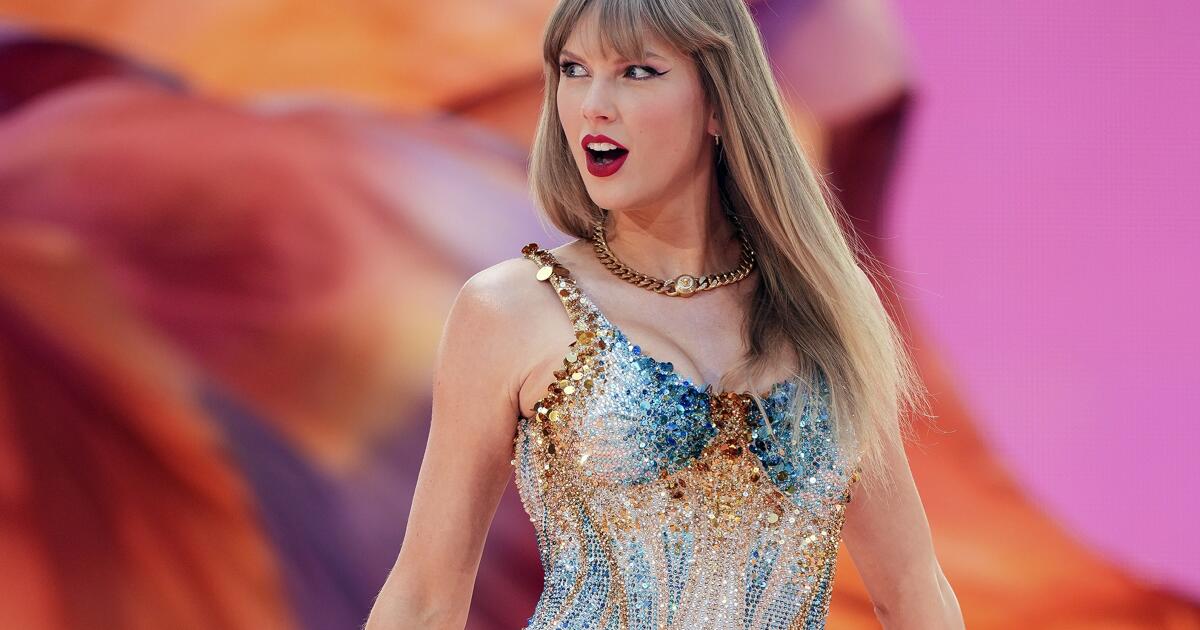WASHINGTON —
Former President Donald Trump has been active on social media as Democrats gather for their convention in Chicago, but some of his posts have little to do with reality.
Ahead of the Democratic National Convention, he posted a fake image of someone resembling Vice President Kamala Harris addressing what appears to be a communist rally in Chicago with a depiction of a red banner and a communist symbol. That followed his reposting of a fake video of himself dancing alongside billionaire Elon Musk, one of his most vocal supporters.
Just before the convention began, he reposted a picture of Taylor Swift in an Uncle Sam outfit saying he was endorsing her campaign, something she has never done.
These are the latest examples of Trump promoting images produced by artificial intelligence tools to attack his opponents or create illusions of support around his own campaign. This is in line with a long-standing strategy in which Trump amplifies certain messages, from QAnon supporters to those who deny the results of fair elections, to score political points and satisfy his base by promoting alternative realities.
Some of the images and videos Trump has shared are cartoonish or obviously fake. However, the rise of AI-generated content on political social media has experts concerned, who say it can be used to push more insidious and credible disinformation. As fake images, videos and audio created by generative AI models begin to saturate social media, they also risk eroding people’s trust in what they see and hear.
“AI-generated deepfakes of Taylor Swift are yet another example of the power of AI to create misinformation that deceives and scams voters,” said Lisa Gilbert, co-president of Public Citizen, a progressive consumer rights group that has pushed for legislation to regulate AI. “The potential harms to our society that could result from such misinformation, including abuses in our elections, are far-reaching and immensely damaging.”
An AI-generated image on Trump’s Truth Social post, shared Sunday, showed women wearing “Swifties for Trump” T-shirts — a reference to the artist’s devoted fans. The fake image showing Swift dressed as Uncle Sam included text that read, “Taylor wants you to vote for Donald Trump.” In his repost of the image, Trump added, “I do!”
One of the images Trump shared included a small satire hashtag, though he did not clarify whether he meant his post was a joke.
Taylor Swift
(Ashley Landis / Associated Press)
Swift, who is still on her world tour and has a show scheduled for Tuesday night in London, has not made any endorsements in this year’s U.S. presidential race. Her spokesman did not respond to multiple messages seeking comment.
For Republicans outside Trump’s orbit, the attention to someone like Swift, one of the most popular artists in the world, is about generating noise for Trump at a time when much of the attention is on Harris and the Democrats.
“This is how he and the campaign can take back the news cycles,” said Doug Heye, a longtime Republican spokesman and operative. “I don’t think you can say it’s in his favor, but I think we all know, if you want people to talk about you, Taylor Swift is a great way to do it.”
A Harris spokesperson did not respond to questions about Trump’s use of AI-generated images.
Trump supporters often create social media posts and memes using AI-generated images, some of which are shared by the former president.
Before Trump shared the fake images of Swift, his supporters had created and posted their own AI-generated videos and images featuring the pop star appearing to support Trump. They also shared numerous images of Harris dressed as a communist leader or addressing a Soviet crowd.
Political operatives have long been concerned about what the rise of artificial intelligence could mean for elections.
Some members of Congress have pushed for legislation to regulate the use of AI-generated images in politics, but no legislation has been passed to do so. The Federal Communications Commission (FCC) has proposed requiring political advertisers to disclose their use of artificial intelligence in television and radio ads, but such a rule would not affect social media platforms.
While several social media companies have rules for labeling AI-generated content, they are not always enforced. Across all platforms, misleading, realistic images of Trump and Harris rack up millions of views, with some users failing to recognize that what they are seeing is fake.
Given her influence and millions of fans, Swift has often become a trending political topic during election years.
Taylor Swift
(George Walker IV / Associated Press)
In 2020, the singer endorsed President Joe Biden, writing a month before the election that she was going to support then-vice presidential candidate Harris, this year’s Democratic presidential nominee, in her debate against then-Vice President Mike Pence. She also openly criticized Trump before the 2020 election, saying he had stoked “the fires of white supremacy and racism.”
While she has remained on the sidelines so far this year, she has not escaped the attention of prominent conservatives who worry about an endorsement by Swift for the Democratic presidential nomination.
Fox News’ Jeanine Pirro earlier this year warned Swift not to “get involved in politics.” Fox News’ Sean Hannity urged her to “think twice” before endorsing Biden when he runs for reelection. And Vivek Ramaswamy, a former Republican presidential candidate and vocal Trump supporter, called Swift and her NFL star boyfriend, Travis Kelce, “an artificially culturally propped-up couple” who could make “a major presidential endorsement” this fall.
Some of his supporters have responded to Trump’s posts by taking to social media and declaring their intentions to vote for the former president. Trump’s campaign is capitalizing on that support.
Trump spokesman Steven Cheung did not address the use of fake images in response to questions, but called “Swifties for Trump” a “massive movement that grows every day.”
